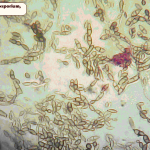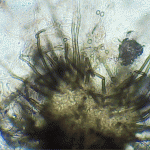Viewing mold photos taken from under a microscope provides evidence of mold growth. Without knowing the sources of mold growth, you won’t know where or how to clean up mold. Finding sources is essential if you want to get rid of all the mold growth. It’s the mold growth that is the source of the spores (reproductive bodies), mold gases, mold mycotoxins, and mold microparticles. For a summary of this information, go to Cutting Edge Information.
Although there are thousands upon thousands of types of mold, only about a dozen genera are common in buildings. “Genera” is the plural of “genus,” which is more like a family of molds. For example, Aspergillus is the genus, but there are 200 species of Aspergillus. Penicillium is a genus, again with around 200 species of Penicillium.
You will see mold photos from many of the common fungal genera that I find at homes below. These include Alternaria, Aspergillus, Chaetomium, Cladosporium, Memnoniella, Mucor, Stachybotrys, Trichoderma, and Ulocladium. There are about a half dozen common black molds at homes, including Chaetomium, Cladosporium, Memnoniella, Stachybotrys, and Ulocladium. Aspergillus niger, one of the 200 Aspergillus species, is black as well. Aspergillus colonies are commonly green.
In air samples, the most common colonies that grow are Alternaria, Aspergillus, Cladosporium, and Penicillium. Stachybotrys tends to have sticky spores which do not become airborne as readily as Aspergillus and Penicillium. I find that Cladosporium spores do not become airborne that easily from sites of condensation (windowsills, shower curtains, bathroom ceilings). Cladosporium spores may blow in from the outside, since this is the most common outdoor mold.
Tip: A common misunderstanding when folk use the mold test kits from a local home supply store is that they see common black Cladosporium colonies growing and think “Black Mold!!” Relax. ‘Chances are these colonies are just Cladosporium and not Stachybotrys. See the mold photos below.
I could find any of these genera with tape samples, but Cladosporium is the most common in areas of condensation, and Aspergillus and Penicillium are very common in areas of leaks by drywall and higher humidity (such as behind walls in finished basements). Other common black or dark fungi in areas of leaks at drywall include Alternaria, Chaetomium, Stachybotrys, Ulocladium. If you see a dark green mold growing in the grain of wood around pipe access holes in basement ceilings, that’s usually Trichoderma.
Tip: If your house has plaster walls, consider yourself fortunate. Mold doesn’t like plaster, though it can grow on paint on the plaster.
Some fungi (another word for “mold”) need more water than other molds. For example, Stachybotrys and Trichoderma need prolonged exposure to water. You typically won’t find black Stachybotrys growing on concrete or on a bathroom ceiling, but if a pipe leak went undiscovered in a drywall wall cavity, expect Stachybotrys there. Stachybotrys likes wet drywall.
Don’t equate “common” molds with “harmless.” Treat all fungi with respect. Wear a respirator (P100 or N95) when moving items that might have mold or when working with mold. Know what you are doing before you begin. Check out How to Remediate.
Aspergillus is a very common mold…and it can grow in sinus and lung tissue, etc. It’s a lot easier to take precautions around Aspergillus than to treat for infection with Aspergillus!!!! Mucor likes damp basements and also can grow in human tissue.
Now let’s look at some mold photos of Alternaria, Aspergillus, Chaetomium, Cladosporium, Mucor, Penicillium, Stachybotrys, Trichoderma, and Ulocladium. These are among the main fungal players in a home. All photos were taken at 600X (600 times as large as life). High levels of mold can be present that are not visible to the naked eye.









